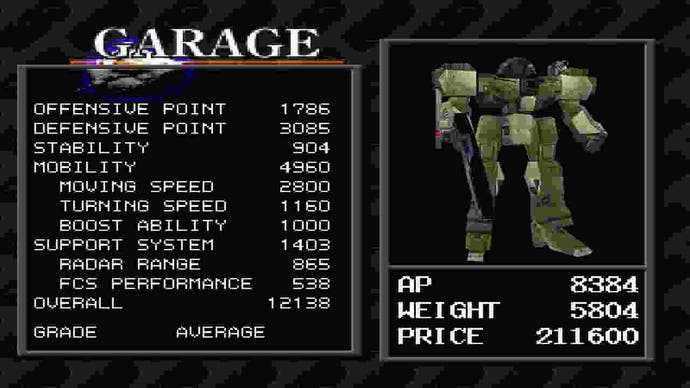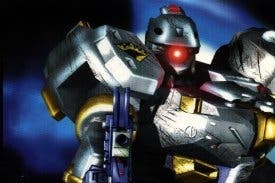The Soulful machinery of Armored Core
There's plenty of life left in what used to be From Software's flagship series.
Last month I took the plunge and bought Monster Hunter 4 Ultimate, after the traditional probationary period of looking on resentfully while people rhapsodise about it on Twitter. Amongst other things, this has meant wrestling once again with my launch model 3DS's lack of a second analog stick. Can you recall console gaming before the advent of analog stick controllers? I genuinely can't imagine how we pulled it off. Strafing around corners must have felt like feeding your hand through a vending machine in search of a reluctant Snickers. Moving the cursor in an RTS must have felt like steering an F1 car with your feet.
As I suggested in last week's Steel Battalion: Heavy Armor retrospective, however, limitations of this sort can be opportunities to discover something about features or mechanics we take for granted. In MH4U's case, I've developed a new appreciation for how important even the most basic surround sound effects can be in a game with long recovery animations, roving packs of velociraptors, and a camera system that often feels like it's sitting back to eat popcorn. And besides, it could be worse. I could be playing the original Armored Core.
Armored Core was "ahead of its time" in the sense that it felt like a game from the future that had elected, out of some howling, trans-dimensional spite, to become magically playable on old hardware that isn't quite up to the task. Worshippers had to contend with a couple of seemingly irreconcilable truths: (1) that Armored Core is a nippy 3D mech combat game with aerial fighting in which you must keep a target on-screen and in range to acquire a lock, and (2) that Armored Core is a game in which you look up and down by tapping the shoulder buttons. Did I mention that it's a From Software title? Because you've probably guessed.

On certain missions, a prevalence of low corridors and sluggish, dinky opposition conspired to make the control scheme bearable. But every now and then you'd run into a proper AC pilot in an arena environment, a tough and agile foe armed with the full competitive arsenal of boosters, homing missiles and laser blades, and your index fingers would respond as though plunged into a bucket of ice cubes.
Still, as with Monster Hunter, mastering Armored Core's arcane handling is a source of enduring glee, and there's plenty to learn about game design on the way. Above all, firing up the game today illuminates how much effort developers now pour into making lock-on mechanics invisible. In place of the old glowing HUD pincers around a target, titles like Assassin's Creed contrive to make us conscious of what we're in a position to punch via delicacies of camera angle or lighting. Much thought has also been expended on the art of letting players break the lock seamlessly - into isolating the fine degrees of analog stick input that separate "tactical backflip" from "headlong rout", without asking you to hit another button.
As impressive as these techniques often are, it can feel like rewarding depths of interaction have been concealed for the sake of elegance alone. The popularity of certain exploits shows how communities may chafe against such strategies - look at quickscoping, in which you take advantage of an autolock feature that is artfully hidden within the kinetic thrill of zooming to ironsights view. Armored Core doesn't just leave its lock-on feature in the open - it lets you fiddle with it by altering the design of your mech. If you're partial to sniping, you can invest in an FCS module that gives you a narrow lock-on reticule which picks up targets at enormous range. Or, you can play it safe with a wide, shallow aiming window, ideal when battling nippy jet-fighters with MG turrets. It appeals in the same way that it's satisfying to learn about how Bethesda created the illusion of riding a metro train in Fallout 3. There's a sense that you're being let into the inner circle, entrusted with hallowed secrets of the trade, while other developers labour to keep the clockwork out of view.

Armored Core's exploration of the art of locking-on is echoed by From Software's most recent games. One component of mastery in a Souls game, for instance, is learning to live without your lock-on, which often leaves you at a disadvantage when fighting large bosses with multiple targetable limbs or an entourage of low-level enemies. This is punishingly worked through in Bloodborne's battle with the Vacuous Spider, Rom, where locking onto the boss can leave you blind to the activities of her arachnid guard, who may seize their opportunity to insta-kill you with a diving headbutt.
Customisation, of course, is what Armored Core is most famous for. Even today, the original game's array of robot arms, legs, gunparts, cores and generators shows up the majority of its peers. But it's not just a question of sprawl, or of forking out for the juiciest kit. The contents of the game's garage are subject to strict balancing considerations - whether those shapely reverse-jointed legs you've just bought are robust enough to carry the hunk of repurposed battleship hull you're piling on top, or whether your core generator has the muscle to keep a brace of laser cannons humming in addition to that fancy cranial radar.
In this, the game again looked forward to the stringent architecture of From's later franchises, and laid the foundations for a community of uncommon resourcefulness. Over a decade down the line, industrious souls still update the Armored Core legacy forums with details and pictures of fine-tuned AC1 mechs. It's the kind of loyalty you earn by placing a staggering quantity of options at the player's disposal, while obliging players to think really hard about how to deploy them - an act of real trust in the context of an industry that has always been a little terrified of challenging its customers too much.
After obsessing over the first game as a teenager, I managed to skip the rest of the series - including the entirely duels-focused Masters of Arena, which arguably represents Armored Core at its purest - till I wound up reviewing Armored Core 5's online features on Xbox 360. That spell of disinterest is largely the fault of the franchise's fiction, which is weirdly anodyne - long story short, it's the near-future, the world is a greying expanse of concrete, and there are corporations fighting for dominance. But the flourishes of misshapen, polychromatic lunacy that are possible care of the customisation system do much to lift the mood, as does the friendliness of the average AC player. I've never been quite as affected by a multiplayer interaction as I was when some veteran walked me through the act of saving and sharing a paint-job, after expressing delight at my mech's glaring mismarriage of purple and green.
Armored Core was once From's crown jewel, but misfires during the PS2 years scraped away much of its lustre, and while the series continues to be very popular in Japan, it has never really broken into the overseas market. The strength of the most recent iterations on Xbox 360 and PS3 suggest that there's plenty of juice left in the lemon, however. Should the Souls games ever lose their way, it's reassuring to know that From has an experience this generous, this exacting to fall back on.









